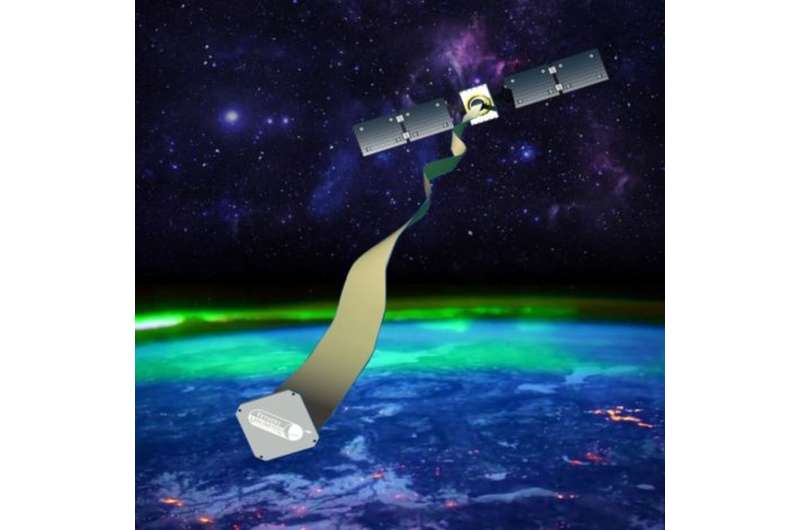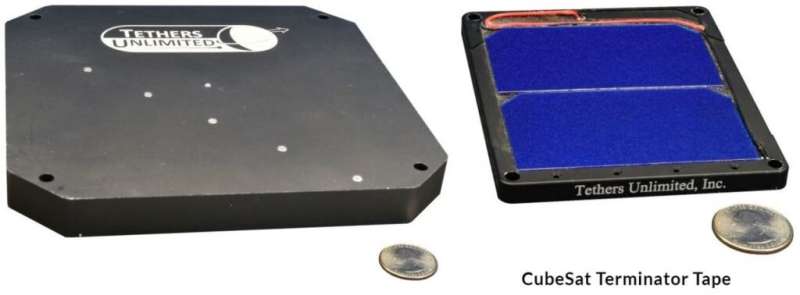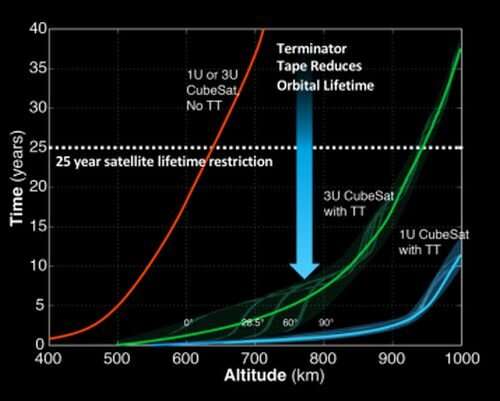Credit: Tethers Unlimited.
A company called Tethers Unlimited has deployed its de-orbiting tether in a successful test on the Prox-1 satellite. The satellite is one of four that are carrying the device, called the Terminator Tape. Rather than stay in space for years or decades and add to the growing problem of space debris, Prox-1 is using its Terminator Tape to slowly lower its orbit.
The Terminator Tape is a low-cost solution to the problem of removing inactive satellites from orbit. The space industry is booming right now, and that's feeding into the growing space debris problem. New guidelines are being developed to deal with problem, and eventually, there will be restrictions governing a satellite's lifetime.
Tethers Unlimited is developing their de-orbiting technology in response to these measures.
The Terminator Tape is a compact lightweight module—less than 1 kilogram—that attaches to CubeSats, NanoSats and Small MicroSats. It has a small footprint and its operation poses no risk to the operation of the satellite, according to Tethers Unlimited.
The tape can be deployed by command or by timer, and consists of a long, conductive tape with two optional solar cells. When deployed, it "generates neutral particle drag and passive electromagnetics drag to hasten the de-orbit," according to Tethers Unlimited's website.
During the Prox-1 test, an independent timer was used, and a 70 meter-long tape was deployed in early September 2019. According to the U.S. Space Surveillance Network, Prox-1 lowered its orbit 24 times faster than satellites without the Terminator Tape.
Credit: Universe Today
"Three months after launch, as planned, our timer unit commanded the Terminator Tape to deploy, and we can see from observations by the U.S. Space Surveillance Network that the satellite immediately began de-orbiting over 24 times faster," said Dr. Rob Hoyt, TUI's CEO, in a press release. "Rapidly removing dead satellites in this manner will help to combat the growing space debris problem. This successful test proves that this lightweight and low-cost technology is an effective means for satellite programs to meet orbital debris mitigation requirements."
When the Terminator Tape is deployed, the Earth's gravity pulls it tight and and aligns it vertically. The tape then works by interacting with the Earth's magnetic field and ionosphere. As it travels at high speed through the Earth's magnetic field lines, a current is induced in the tape. It is basically converting the satellite's orbital energy into electrical energy. The tape acts like a conductor and its electrical current interacts with the magnetic field to create drag.
As a satellite lowers itself into the atmosphere, the tape will create further drag, and eventually the satellite will burn up.
Credit: National MagLab
The function of the Terminator Tape depends on Lorentz force interactions. It works especially well in low Earth orbit (LEO) where there is a useful density of electrons. The Terminator Tape is designed to lower a satellite's orbit, but depending on the orientation, conducting tapes like this can also be used to raise an orbit.
The actuator that deploys the tape is made of a shape memory alloy (SMA). These alloys have a very special property. When they're cold, they can be deformed, but when they're heated, they return to their original shape. To activate, the SMA actuator needs a very low but constant power source. The Terminator Tape doesn't need any power from the satellite; it can be mounted with its own tiny solar cells. This means it can be attached to defunct satellites to de-orbit them.
These types of tapes can also be reversed. A power supply can drive the current in the opposite direction, which can raise a satellite's orbit. One potential use of these types of devices is on the International Space Station. It needs to fire thrusters regularly to maintain its orbit, and the fuel for those thrusters has to be delivered from Earth. With the right tether, the thruster fuel requirements can be reduced or eliminated.
-
The NanoSat Terminator Tape (l) and the CubeSat Terminator Tape (r.). Credit: Tethers Unlimited
-
Performance curve of Terminator Tape for 1U cubesats in orbits up to 1200 km and for 3U cubesats up to 950 km. Credit: Tethers Unlimited
But for now, the Terminator Tape is being tested on small satellites like the Prox-1 mission. And there's more testing being planned.
Tethers Unlimited say they're developing a test mission with Millennium Space Systems, TriSept and RocketLab. They're creating a low-Earth flight experiment with rigorous scientific controls to measure and compare the performance of two identical satellites: one with a Terminator Tape and one without.
That mission's called DragRacer, and it's a 25-kg satellite that will split into two identical packages when it reaches its 400-kilometer circular sun-synchronous orbit. One will deploy a Terminator Tape and one won't. One of the satellites will stay in orbit for about eight months or a year, while the one with the tape is expected to de-orbit into Earth's atmosphere within two to four weeks.
Source Universe Today


























